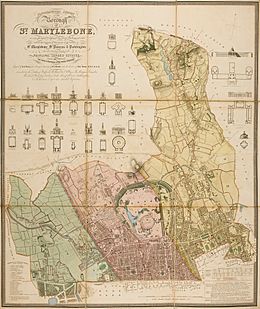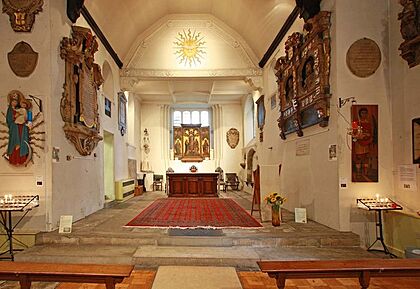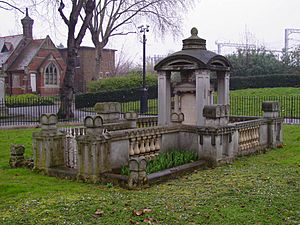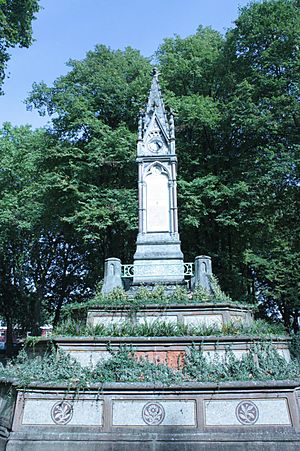St Pancras Old Church facts for kids
Quick facts for kids St Pancras Old Church |
|
|---|---|

St Pancras Old Church
|
|
| Denomination | Church of England |
| Tradition | Anglo-Catholic |
| Administration | |
| Parish | Old St Pancras |
| Deanery | South Camden |
| Archdeaconry | Hampstead |
| Episcopal area | Edmonton |
| Diocese | London |
| Province | Canterbury |
St Pancras Old Church is a historic Church of England church in the Somers Town area of London. It is named after Saint Pancras, a Roman boy who became the patron saint of children.
Many people believe this is one of the oldest places where Christians have worshipped in England. The church was mostly rebuilt during the Victorian era. It is different from the nearby St Pancras New Church, which was built much later in the 1820s.
Contents
History of the Church
The church once served the huge parish of St Pancras, which stretched from near Oxford Street all the way to Highgate. A parish is an area that has its own church and priest.
How Old Is It?
Some stories say that a church has been on this spot since the year 314 AD. However, like many very old churches, there isn't much written proof or archaeological evidence to know for sure when it started.
Roman and Saxon Times
There is a local belief that the church was founded during the Roman period. Some historians thought it might have been built on the site of a Roman meeting place.
In 597 AD, Pope Gregory the Great sent a monk named Augustine of Canterbury to England to spread Christianity. Augustine brought holy items, called relics, of Saint Pancras with him. The first church he started in Canterbury was named after St Pancras. Some people think he also founded this church in London.
When the church was being rebuilt in 1847, workers found Roman tiles in the tower walls. They also found an altar stone that might be from the 7th century. This suggests the church is at least from the Anglo-Saxon period.
A Church Through the Ages
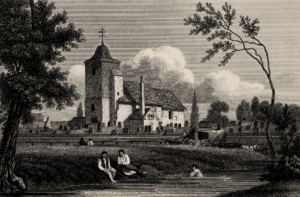
In the Middle Ages, a small village grew around the church. But in the 1300s, people started moving away, probably because the area often flooded. The main village moved north to what is now Kentish Town.
This left the church feeling isolated. After the English Reformation, when the country's main religion changed, the quiet churchyard became a popular burial place for Roman Catholics. They were not allowed to be buried in many other London churchyards at the time.
By the 1700s, the church was in bad shape. Services were only held there once a month. When London grew, a much larger church, the St Pancras New Church, was built nearby in 1822. The Old Church then became just a small chapel.
The Big Rebuild in Victorian Times
By 1847, the Old Church was nearly falling down. But because more people were moving into the area, it was decided to fix it. In Victorian times, "restoring" a church often meant rebuilding it almost completely.
The old tower was taken down, and a new one was built on the south side. The whole outside of the church was given a new stone surface. These changes made the church much bigger, so it could hold 500 people instead of just 120.
The church was damaged by bombs in the Second World War and was repaired in 1948. Today, it is a Grade II* listed building, which means it is a very important historic site that is protected.
The Church Today
St Pancras Old Church is an active church in the community. It has a special connection to the nearby St Pancras Hospital. In 2007, it celebrated the opening of the St Pancras International train station with a special service.
The church is also a popular place for concerts. Many famous musicians have performed here, including Laura Marling, Sam Smith, and Brian Eno.
The Famous Churchyard
The churchyard is the biggest park in the area. It is a peaceful place with large, old trees. For centuries, it was a burial ground for local people and for Roman Catholics from all over London.
Many interesting people were buried here. These include the composer Johann Christian Bach, who was a son of the famous Johann Sebastian Bach, and the writer Mary Wollstonecraft. Although Wollstonecraft's body was later moved, her original tomb is still a memorial to her and her husband, William Godwin.
The famous architect John Soane designed a large tomb for his wife and himself in the churchyard. This tomb is now a Grade I listed structure. Some people think its shape inspired the design of Britain's classic red telephone box.
The Hardy Tree
In the 1860s, part of the churchyard had to be cleared to build the Midland Railway line into St Pancras station. A young man named Thomas Hardy, who later became a famous author, was in charge of moving the gravestones.
He stacked the old headstones around an ash tree, which became known as "The Hardy Tree." For over 150 years, it was a famous London landmark. Sadly, the tree fell down in December 2022 after a storm. The gravestones still remain in a circle.
The Burdett-Coutts Memorial
In 1877, the churchyard was turned into a public park. Many of the gravestones were moved. A wealthy local woman named Angela Burdett-Coutts paid for a large monument, shaped like a sundial, to be built.
The monument lists the names of many important people whose graves were lost when the park and railways were built. Some of the names on the memorial include:
- Chevalier d'Eon, a famous French spy and fencer.
- John Flaxman, a sculptor.
- Pasquale Paoli, a hero from Corsica.
- John Walker, who wrote a famous dictionary.
Pop Culture Connections
- In 1814, the poet Percy Bysshe Shelley and the writer Mary Godwin (later Mary Shelley) met at her mother's grave in the churchyard to plan running away together.
- The author Charles Dickens mentioned the churchyard in his novel A Tale of Two Cities.
- In 1968, the music group The Beatles had a famous photoshoot in the churchyard to promote their song "Hey Jude". A bench in the park has a plaque to remember their visit.
Images for kids


